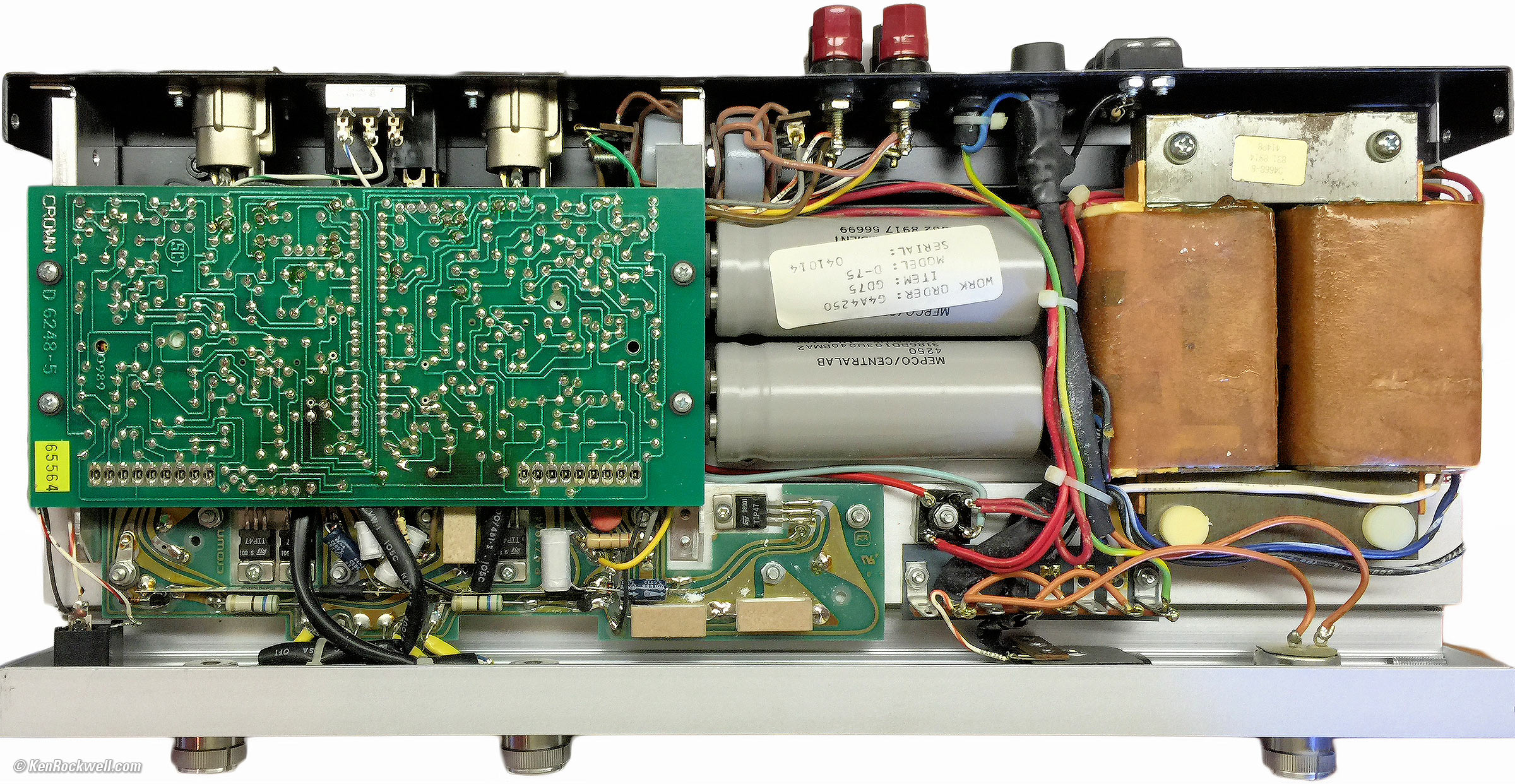Home Donate New Search Gallery Reviews How-To Books Links Workshops About Contact
Crown D-75
35 WPC Power Amplifier (1978-c.2000)
Made in the United States of America
Intro Specifications Measurements
Crown D-75 (1 RU, rated 35 watts per channel, 10 lbs./14.53 kg, measured 15 watts idle power draw, about $100 used) in optional walnut veneer cabinet. The cabinet is uncommon and sells for about $160 if you can find one. enlarge. I got these at this link directly to them at eBay (see How to Win at eBay).
This all-content, junk-free website's biggest source of support is when you use those or any of these links to approved sources when you get anything, regardless of the country in which you live. Buy only from the approved sources I use myself for the best prices, service, return policies and selection. Thanks for your support! Ken.
Rear, Crown D-75. enlarge.
October 2021, April 2015 Crown reviews audio reviews all reviews
Introduction top
Intro Specifications Measurements
The Crown D-75 is a compact and extremely high quality professional power amplifier. It is one of the most classic pro amplifiers of all time, being used in just about every radio station, recording studio and remote truck for use with nearfield monitors or other small speakers. You'd see this anyplace small speakers needed to be driven, as well as to power the speakers in the station's lobby. The sample here has an added "MONITOR" label, which is typical of how these were installed: you turn those knobs to turn the monitors up or down.
It has no fan. It cools itself through convection, radiation and conduction through its all-aluminum chassis and black steel top cover.
They were wildly popular in every studio and remote application because not only are they tiny and lightweight, they are bulletproof and stupidproof, and their front-panel volume controls and headphone jack mean that any signal can be routed to them, and you can monitor it without needing any other volume control.
Crown made over 100,000 of these over the period of a few decades, and they are a professional, not consumer product, that sold for the equivalent of about $1,000 when new.
The D-75 also makes a fantastic headphone amplifier, especially for high-impedance and/or power hog headphones like Audeze. The headphone jack is wired directly to the speaker outputs, so it has zero output impedance, and the D-75 is so quiet you're good to go. It's silent with the HD 650, and has more than enough output to blow them out.
Be careful, it's easy to blow out low-impedance headphones if you do something stupid. Even if you do use ultra-sensitive low-impedance headphones like the beyerdynamic T51i, there is a little noise (but no hum) with silence, and no audible noise once the music start playing — just be careful if you knock the level controls; you could burn out 32 Ω phones in an instant, much less your hearing.
The speakers don't mute when you plug in headphones. Dedicate this amplifier to headphone use if you want to.
It turns on and plays immediately, and plays for several seconds after power is turned off.
Since professional monitor speakers all have dedicated internal power amplifiers today (thus the name "active" monitors), these gems have flooded the used market and you can get them for $100 or less if you know How to Win at eBay.
This D-75 and passive speakers are much quieter than most active monitors; you won't hear any hiss or hum even if you put your ear on your speaker.
The D-75 has professional balanced XLR inputs, as well as a true unbalanced input for home Hi-Fi use. When you plug in a ¼" plug, the balanced input receiver is completely and automatically bypassed for even cleaner signal from an unbalanced input. Most other amps simply unbalance the input and use the same circuitry when you plug-in a ¼" plug, while the D-75 actually switches inputs automatically to bypass the balanced receiver when a plug is inserted. Use two ¼" to RCA adapters and you're in Hi-Fi Heaven.
IOC and SIGNAL LEDs Introduction top
Crown's IOC (Input-Output Comparator) LEDs are brilliant. They compare input to output, and light the LED if anything is even slightly distorted.
This way you always know if your signal is clean, or if you're at the hairy edge (occasional blinks), or buried (continuous red). Therefore it's easy to push this amplifier and your system to get the maximum real-world power of which this amplifier is capable, regardless of your program material or speakers.
Yes, this is an amplifier with a lot of internal feedback, but if anything gives rise to any sort of distortion, the IOC LED blinks and you know it before it becomes audible.
The IOCs work great. When I test in the lab, they light instantly and far faster than my lab analyzer lets me know anything's amiss. They make testing this amplifier fast!
The SIGNAL LEDs blink at varying levels as the program varies. They come on at about 50 mW and get brighter and brighter as the level increases, and are always flickering along with your music.
These four simple LEDs do a fantastic job of letting you know what's going on at a glance. The IOCs are the best overload indicators in the business. They catch any instantaneous distortion, and light bright red long enough for you to see it.
Crown D-75. enlarge.
History Introduction top
1960s ~ 1977: D-60
Crown's first little 1RU amplifier was the 30 WPC D60, made from the 1960s through 1976, which was replaced by this D-75.
1978 ~ 2000s: D-75
This D-75 adds more power in the same tiny package, as well as the very useful IOC and SIGNAL LEDs.
2000s ~ 2014: D-75A
The D-75A is a cost-reduced version that came out sometime in the 2000s.
It should have the same basic performance, but Crown took away the speaker connectors and replaced them with a terminal strip to save itself money, and which makes sense as most of these are installed permanaly in studios and performance spaces.
Crown also removed the dedicated unbalanced input and instead uses XLR combo jacka for balanced inputs only. The combo jacks will accept XLR or 1/4", but it's a 1/4" TRS balanced input, not the mono 1/4" jack that completely bypassed the balanced input for home Hi-Fi use — which is probably what most of you reading this want.
The D-75A also has a Mono mode, but you have to open the case to switch it.
Crown offshored the D-75A to China in its last days before it was discontinued in 2014. It's best to avoid the newer D-75A, even if it looks cooler in black.
Inside the Crown D-75. enlarge.
Specifications top
Intro Specifications Measurements
Rated Output Power
8Ω Stereo: 35 WPC (15.44 dBW), 20-20,000 Hz at less than 0.05% THD (40 WPC (16.0 dBW) at 1 kHz at 0.1% THD).
4Ω Stereo: 45 WPC (16.53 dBW), 20-20,000 Hz at less than 0.05% THD (55 WPC (17.4 dBW) at 1 kHz at 0.1% THD).
8Ω Mono: 95 watts total (19.77 dBW), 20-20,000 Hz at less than 0.05% THD; 110 watts total (20.41 dBW) at 1 kHz at 0.1% THD).
It has a standard unregulated linear power supply that provides ± 30 V DC rails with twin 10,000 µF 40Vcapacitors.
Inputs specifications top
Two balanced XLR, 20k Ω (10k Ω if you use only one side for the wrong kind of balanced input).
Two mono ¼" unbalanced, 25k Ω.
Input Sensitivity specifications top
812 mV ± 2% for 35W into 8Ω.
Frequency Response specifications top
20 ~ 20,000 Hz ± 0.1 dB at 1 watt.
Phase Response specifications top
20 ~ 20,000 Hz, +10º -15º at 1 watt.
Signal to Noise Ratio specifications top
106 dB below 35 W (15.44 dBW) into 8Ω.
This is -90.56 dBW or 875 pW or 83.85 µV or -81.53 dBV.
THD specifications top
< 0.001% from 20 ~ 400 Hz from 10 to 250 mW, increasing linearly to 0.05% at 20,000 Hz at 35 W.
IMD specifications top
< 0.05% from 10 to 250 mW.
<0.01% from 250 mW to 35 W.
Slew Rate specifications top
6 V/µS.
Damping Factor specifications top
> 533 damping factor into 8 Ω.
< 15 mΩ output source impedance.
Output Connectors specifications top
Lab standard 3/4" spaced 5-way binding posts.
Designed for standard MDP lab connectors.
Quality specifications top
Made in Elkhart, Indiana, USA.
Power Input specifications top
120 VAC ± 10%, 50 ~ 400 Hz.
Internal taps also for 100 V, 200 and 220 V (all ± 10%).
NE2H neon pilot light with 27k Ω dropping resistor.
Rated Power Consumption specifications top
15 W idle, 240W max.
2A rear-panel fuse and 2.5A internal fuse.
See also Actual Power Consumption.
Size specifications top
1 RU.
1.75 x 19 x 8.375" HWD, depth is behind mounting flange.
45 x 483 x 223 millimeters HWD, depth is behind mounting flange.
Weight specifications top
10 lbs. (4.53 kg).
Export specifications top
Crown labled their export models as Amcron, not Crown.
Price, U. S. A. specifications top
October 2021: about $150 used if you know How to Win at eBay.
April 2015: about $100 used if you know How to Win at eBay.
1991: $900, corrected for inflation in 2015 ($524 list price at the time).
1990: $950, corrected for inflation in 2015 ($524 list price at the time).
1989: ($524 list price at the time).
1988: ($524 list price at the time).
1987: ($524 list price at the time).
1986: ($524 list price at the time).
1985: $1,150, corrected for inflation in 2015 ($524 list price at the time).
1984: ($499 list price at the time).
1980: $1,275, corrected for inflation in 2015 ($449 list price at the time).
1979 (D-75): $399 list price at the time).
1978 (D-75): $1,350, corrected for inflation in 2015 ($349 list price at the time).
1977: $299 (D-60)
1976: $299 (D-60)
1975: $269 (D-60).
1974: $249 (D-60).
1973: $249 (D-60).
1973: $229.95 (D-60).
1973: $229 (D-40).
Measurements top
Intro Specifications Measurements
Crown D-75. enlarge.
These measurements are made with an exotic Rohde & Schwarz UPL laboratory analyzer. The traces from the Rohde & Schwarz UPL laboratory analyzer are color coded for the Left Channel and for the Right Channel. When they don't lie on top of each other, it's due to channel imbalance. When they do lie on top of each other, the trace turns blue.
Unless otherwise specified, all measurements are RMS at 1 kHz at 1 W into 8Ω, both channels driven. I used a 120 VAC supply voltage.
These are April, 2015 measurements of a random sample of D-75 made in 1978, bought from a random stranger over eBay. This amplifier is 38 years old, and works swell.
Input Level Gain Channel Balance
Frequency Response Distortion Noise
Input Levels and Power Output measurements top
8 Ω
138.3 mV RMS for 1 W output, unbalanced inputs.
818 mV RMS for 35 W (16.733 V) output at 0.001% THD, unbalanced inputs.
858 mV RMS for 38.5 W continuous output at IOC, unbalanced inputs.
1.040 V RMS for 10 cycles of 1 kHz at 1 Hz PRF for 56.5 W burst power at IOC, unbalanced inputs.
SIGNAL starts lighting at about 50 mW (630 mV) output, and blinks and gets brighter with level above that.
4 Ω
98.0 mV RMS for 1 W output, unbalanced inputs.
657 mV RMS for 45 W output at 0.01 % THD, unbalanced inputs.
710 mV RMS for 52.5 W continuous output at IOC at 0.01 % THD, unbalanced inputs.
933 mV RMS for 10 cycles of 1 kHz at 1 Hz PRF for 90.9 W burst power at IOC, unbalanced inputs.
Playing into my 4Ω-rated B&W 802 Matrix Series 3, I see musical peaks of about 95 W RMS (measured as voltage and calculated for 4Ω) as the IOC lights.
IOC on at 0.01%.
SIGNAL starts lighting at about 100 mW (630 mV) output, and blinks and gets brighter with level above that.
Gain measurements top
Balanced
26.198 dB left, 26.229 dB right, at LEVEL MAX.
Unity gain is at about 10:30 o'clock.
Unbalanced
26.205 dB left, 26.222 dB right, at LEVEL MAX. (20.44x)
26.209 dB left, 26.192 dB right, at LEVEL MAX, MONO.
Unity gain is at about 10:30 o'clock.
Good, this is the same as the balanced input, showing us that Crown does precision work when it comes to making unity-gain balanced input buffers.
Unbalanced |
Left |
Right |
MAX |
+26.205 dB |
+26.222 dB |
4 o'clock |
+25.923 dB |
+25.841 dB |
3 o'clock |
+22.780 dB |
+22.175 dB |
2 o'clock |
+17.145 dB |
+16.608 dB |
1 o'clock |
+8.589 dB |
+7.209 dB |
12 o'clock |
+5.511 dB |
+4.682 dB |
11 o'clock |
+2.170 dB |
+1.102 dB |
10 o'clock |
-1.9275 dB |
-1.8869 dB |
9 o'clock |
-10.252 dB |
-9.345 dB |
8 o'clock |
-38.49 dB |
-39.28 dB |
MIN |
-43.39 dB |
-45.11 dB |
Channel Balance measurements top
Channel balance is essentially perfect at the maximum level control setting.
Of course you'll have to balance them yourself at other level control settings; each channel's control is independent and there are no click stops.
Balanced Inputs
At maximum level, the right channel is 0.031 dB hotter than the left.
Unbalanced Inputs
At maximum level, the right channel is 0.017 dB hotter than the left.
Frequency Response measurements top
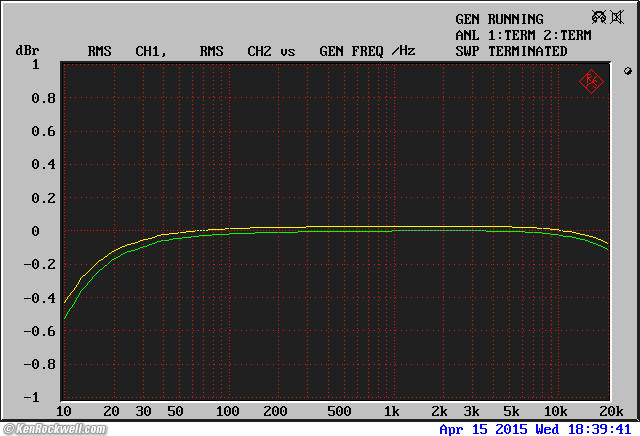
Frequency response.

Phase response.
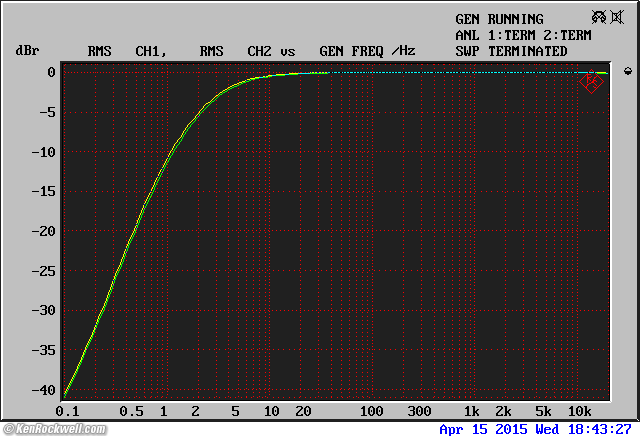
Infrasonic response.
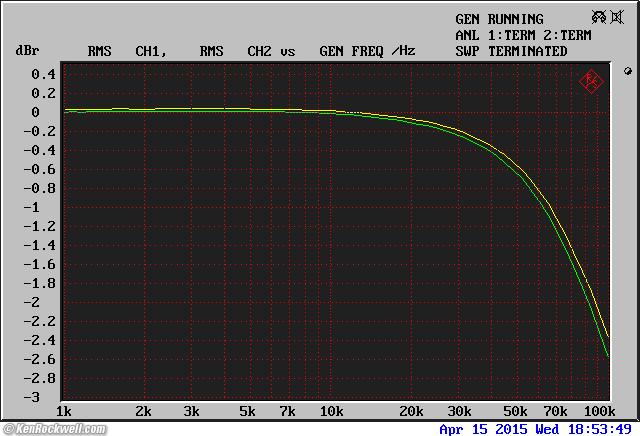
Ultrasonic response.
Distortion measurements top
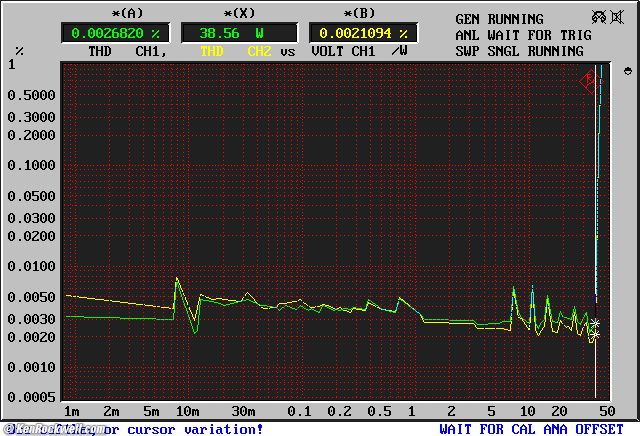
THD versus power.
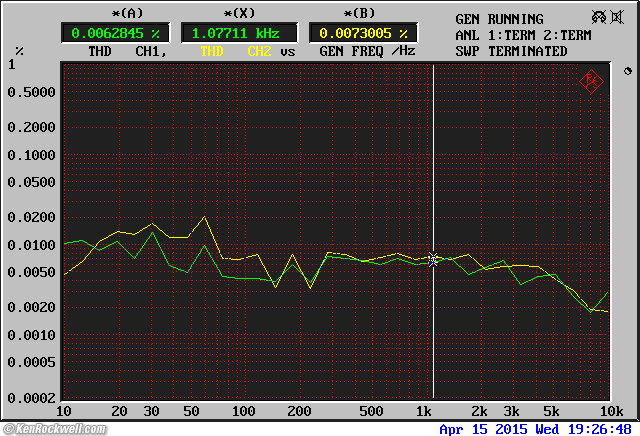
THD at 1 mW.
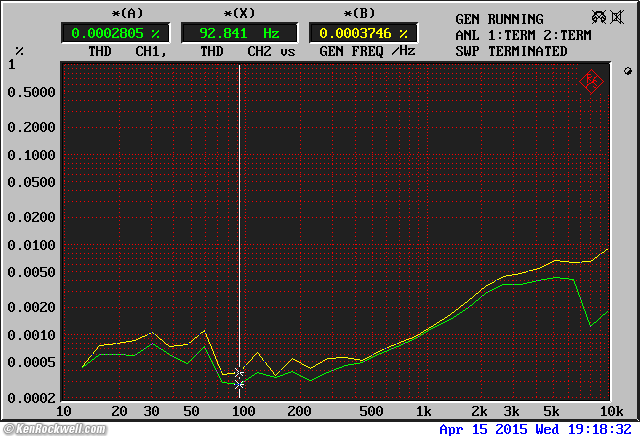
THD at 1 W.
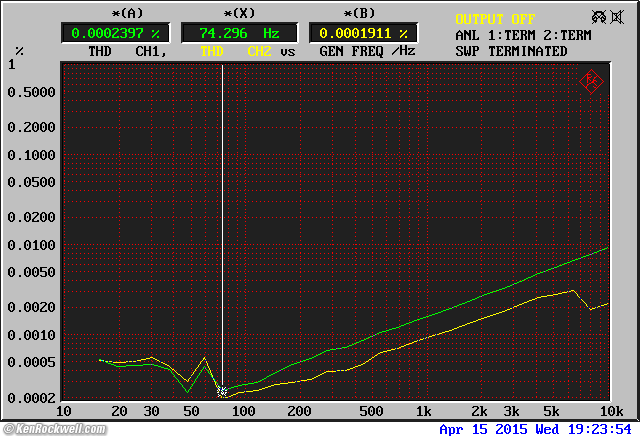
THD at 35 W.
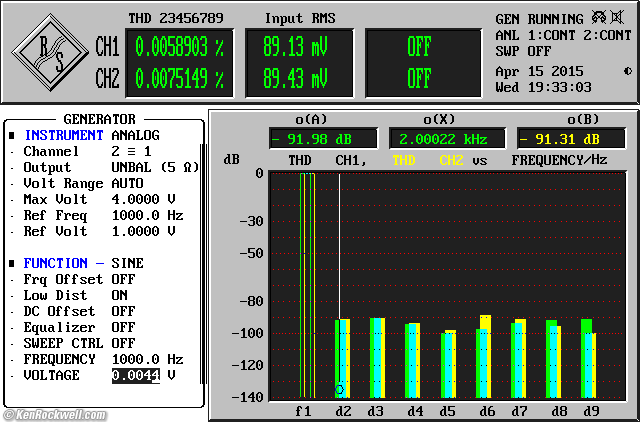
Harmonic distortion content at 1 mW.
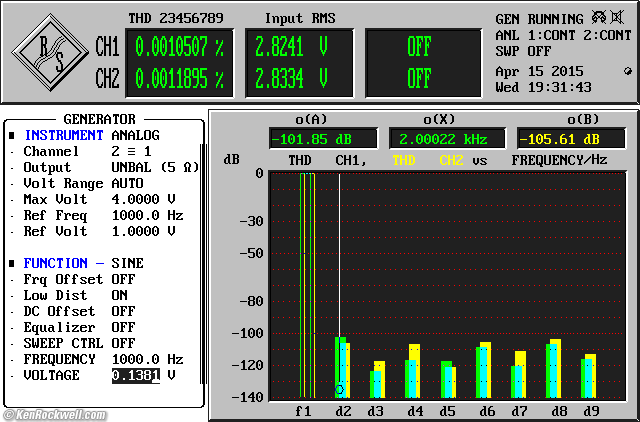
Harmonic distortion content at 1 W.
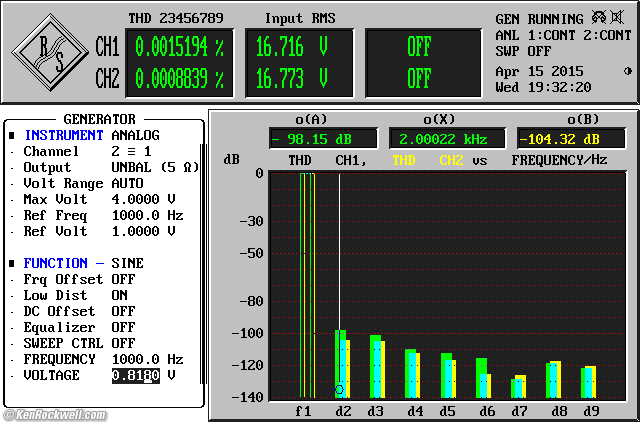
Harmonic distortion content at 35 W.
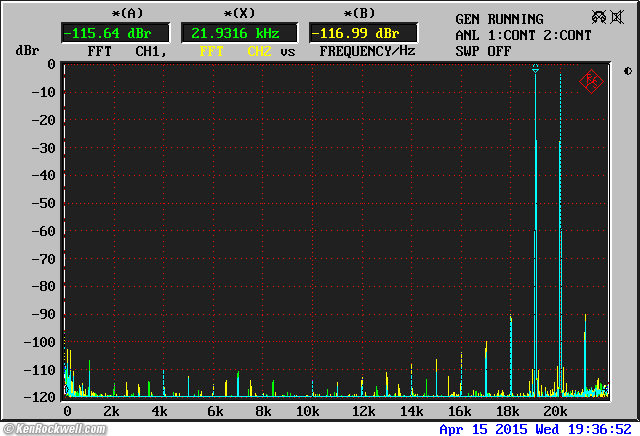
19 + 20 kHz difference-frequency distortion at 1 W.
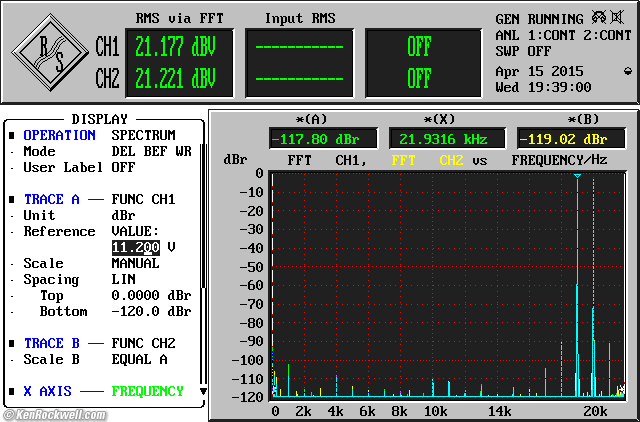
19 + 20 kHz difference-frequency distortion at 16 W.
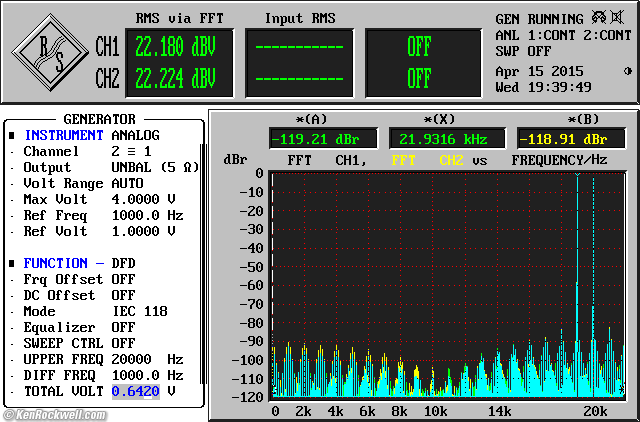
19 + 20 kHz difference-frequency distortion at 21 W just before IOC lights.
Output Noise measurements top
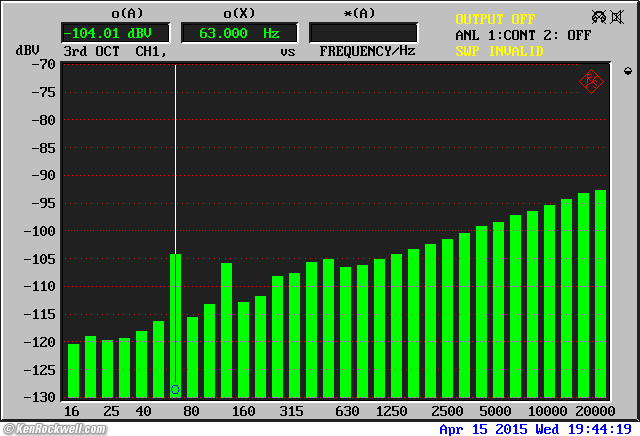
Output noise spectrum.
A Weighted |
A Weighted |
Unweighted 22kHz BW |
|
MAX LEVEL |
-88 dBV A |
-92.5 dBW A |
-85 dBV |
-6 dB (2:30 o'clock) |
-85 dBV A |
-89.5 dBW A |
-81 dBV |
MIN LEVEL |
-88 dBV A |
-92.5 dBW A |
-85 dBV |
The loudest thing you'll hear can be some acoustical transformer buzz, depending on how and where you have the amplifier mounted.
Damping Factors measurements top
Damping Factors at 8Ω
8 Ω |
4 Ω |
|
50 Hz |
516 |
258 |
1 kHz |
516 |
258 |
20 kHz |
51.4 |
25.7 |
Output Impedances
Source Z |
|
50 Hz |
15.5 mΩ |
1 kHz |
15.5 mΩ |
20 kHz |
156 mΩ |
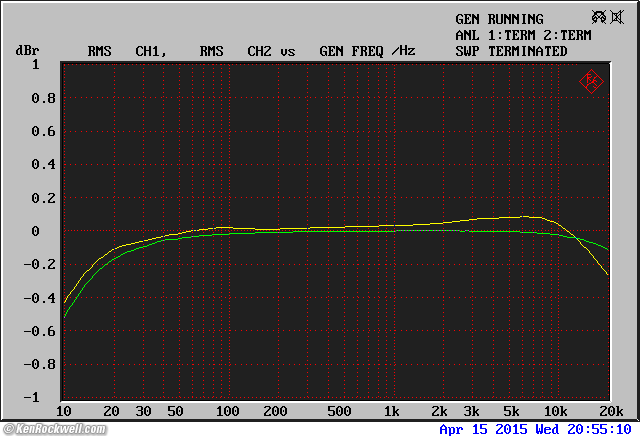
Frequency response driving an 8Ω resistor (green trace) and driving a real B&W CDM2 bookshelf loudspeaker (yellow trace), whose impedance varies between 6 and 45 Ω, a typical loudspeaker load.
4Ω Operation measurements top

THD at 1 W into 4Ω.
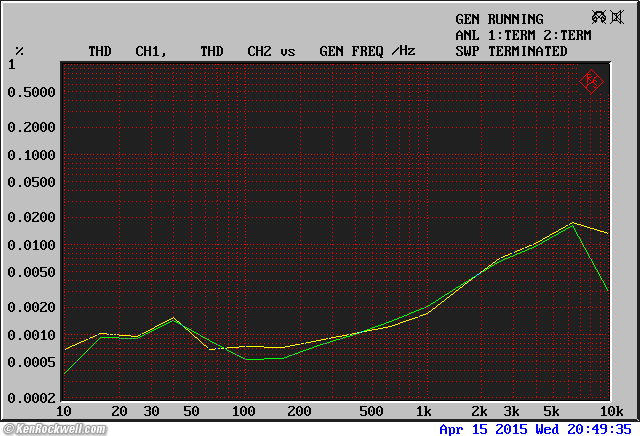
THD at 45 W into 4 Ω.
Actual Power Consumption measurements top
15.4 watts at idle, warm or cold.
It draws 35 W at 1 WPC.
It draws 146 W at 35 WPC.
Sound top
Intro Specifications Measurements
About the only sound that may come out of this amplifier is some power transformer buzz. If yours hums, change the way or where it's mounted to minimize it.
Its outputs are silent, much better than active speakers more popular today.
If you get hum at the speaker outputs, remove the ground jumper and store it rotated 90º on either of the two screw terminals.
Otherwise this is a typical good solid-state amplifier; it has no sound of its own. Whatever goes in is what comes out, and if there is any sort of distortion or other problem, the IOC lights to warn you before it becomes audible.
It lacks the euphonic colorations and distortions of tube amplifiers. As a professional product, it lives to serve by faithfully reproducing what it's fed, not trying to make music sound even better than it is.
It's very revealing. You'll hear all the inner detail and details like footsteps behind the stage.
If you want great sound, get a tube amplifier. If you want accurate sound cheap, get one of these.
Usage top
Intro Specifications Measurements
Crown D-75. enlarge.
Inputs
Use the XLRs for balanced input. Crown is serious about common-mode rejection; there is an internal trim for a technician to null it out for perfection.
If you insert a mono ¼" plug into the ¼" jack, a contact in the jack bypasses the balanced input operational amplifier and feeds this unbalanced input directly to the volume control potentiometers.
For Hi-Fi use, use two ¼" to RCA adapters and you have a real, native unbalanced input. This is much better than jock-strapping a balanced input for use with an unbalanced input as you have to do with most professional amplifiers.
In other words, you can leave a balanced input connected, and the D-75 switches between them if you insert a mono ¼" plug.
For home Hi-Fi use, the unbalanced inputs are perfect.
Levels
If used with a preamplifier, you'll get less noise if you turn the volume controls down to optimize the system so the maximum output of the preamplifier is just enough to overdrive the D-75 by a small margin.
In most preamplifier setups, leaving the volume controls all the way up picks up more noise in the line from the preamp, and has you turning the preamplifier level way down.
I usually run my D-75 level controls at about 2 o'clock at home.
Output Connections
The lab-standard banana jacks are always connected; there is no relay.
Use a standard 3/4" spaced dual banana MDP plug for connecting speaker wire.
Always use insulated plugs, never metal ones that can be accidentally shorted.
Yes, it's simple to use lugs or even bare wire if you prefer; that's the beauty of the professional jacks on the back.
Mono Use
This little amp puts out about 100 watts into 8Ω in mono mode. Get two of these for stereo, and you've got 200 watts in only 2 RU for about $200 total.
It's trivial to switch these to mono mode with a switch on the back, but the newer D-75A requires opening the case.
Headphones
The headphone jack is wired directly to the speaker outputs with no series resistor.
This is fantastic for 600Ω headphones or power hogs like the Audeze, but easily can burn-out 32Ω headphones if you do something stupid.
The speakers do not disconnect when you plug in headphones. The speakers do not mute.
You can wire speakers to a stereo ¼" plug and connect them that way, too.
Mounting
This is a professional rack-mount amplifier. It has no feet.
You won't get a wood case with it unless you buy one separately as I did.
Put it on cardboard or a magazine when you get it so you don't damage your furniture.
Get some stick-on rubber bumpers for the bottom if you plan on home use.
It cools itself without a fan. It will get hot if you wrap it in a blanket; let it breath. It loves being rack-mounted, in which case the head conducts through the rack mount.
Electrostatic Speakers
Crown cautions to use a capacitor as a DC bypass if you're driving a transformer input. There are diagrams in the manual.
Recommendations top
Intro Specifications Measurements
If you want a compact, inexpensive, indestructible professional amplifier, there are many reasons that this has been the world's most popular professional amplifier for decades.
It works great to power any desktop or nearfield system, and with its IOC LEDs lighting up before any significant distortion takes place, it's safe to use this where you might need more power. With the IOC LEDs, you always know if you're distorting or not. You can use all the power this amplifier has, regardless of load, and not have to play it softer to stay safe. Unlike consumer amplifiers, play it as loud as you want, and so long as the IOC LEDs don't light, you're not at the edge.
Most people don't realize that 35W is plenty of power for just about anything. A 100W amplifier only goes about one volume control click louder, and with the IOC LEDs you can use all of this amplifier's power without fear of distortion.
It also works especially well as a dedicated high performance headphone amplifier, with far more output and lower output impedance than any other dedicated headphone amplifier.
Enjoy!
Help me help you top
I support my growing family through this website, as crazy as it might seem.
The biggest help is when you use any of these links when you get anything, regardless of the country in which you live. It costs you nothing, and is this site's, and thus my family's, biggest source of support. These places have the best prices and service, which is why I've used them since before this website existed. I recommend them all personally.
If you find this page as helpful as a book you might have had to buy or a workshop you may have had to take, feel free to help me continue helping everyone.
If you've gotten your gear through one of my links or helped otherwise, you're family. It's great people like you who allow me to keep adding to this site full-time. Thanks!
If you haven't helped yet, please do, and consider helping me with a gift of $5.00.
As this page is copyrighted and formally registered, it is unlawful to make copies, especially in the form of printouts for personal use. If you wish to make a printout for personal use, you are granted one-time permission only if you PayPal me $5.00 per printout or part thereof. Thank you!
Thanks for reading!
Mr. & Mrs. Ken Rockwell, Ryan and Katie.
Home Donate New Search Gallery Reviews How-To Books Links Workshops About Contact






